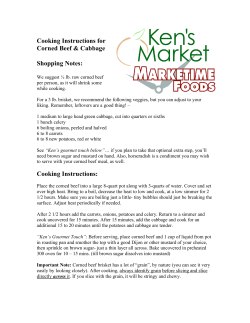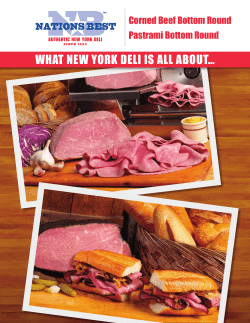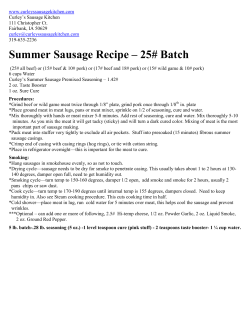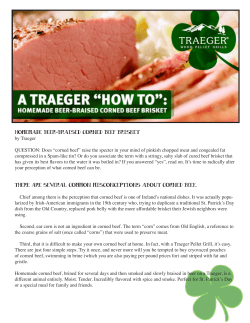
T H E B E E F ... 1 I S S U E 0 1
T H E ISSUE 01 B E E F L O V E R S WINTER 2012 J O U R N A L FREE 1 The paper stock is environmentally responsible paper produced from FSC (mixed sources), certified pulp from well-managed forests and Elemental Chlorine Free (ECF). Phone 02-9463-9333 This publication is published by Meat & Livestock Australia Limited ABN 39 081 678 364 (MLA). Care is taken to ensure the accuracy of information in the publication, however, MLA cannot accept responsibility for the accuracy or completeness of the information or opinions contained in the publication. Readers should rely on their own enquiries in making decisions concerning their interests. Reproduction in whole or in part of this publication is prohibited without the prior written consent of MLA. © 2012. Email themainmeal@mla.com.au Website themainmeal.com.au Editor Natalie Johnson njohnson@mla.com.au Design Mash mashdesign.com.au Published June 2012 CREDITS Printing Southern Colour southerncolour.com.au Paper Stock Cover: Nordset by Raleigh Paper Text: Grange Laser by K.W. Doggett Food Stylist Simon Bajada simonbajada.com Food Photographer John Laurie johnlauriephoto.com Illustration Bradley Jay bradleyjay.co.uk 03 Address Level 1, 165 Walker Street, North Sydney, NSW 2060 Contents Issue N O. 1 –– Winter ‘12 10 Recipes Beef Tartare and Carpaccio 10 Flat Iron Steak 12 Picanha with Relish 16 Coffee Encrusted Eye Rump Steak 18 Slow Cooked Eye of Rump 20 Braised Veal Breast 26 5 Introduction 6 In Conversation –– From Paddock to Plate 8 The Classic Corned Beef 14 Know Your Beef Cuts 22 New Labelling –– Beefs Up Quality (MSA) & WEL COME to the inaugural issue of MEAT & CO, a magazine dedicated to exploring the wonder of Australian beef. Our aim is to entice you to new paddocks and plates, stretch your culinary quests and discover new ways of cooking and serving this most versatile main ingredient. ––– In this issue, we introduce Queensland grazier Stuart Barrett, one of the many Aussie farmers espousing the benefits of sustainable farming practices. We celebrate the humble and comforting slow-cooked Corned Beef dinner, explain the MSA quality grading system; reveal the secrets to serving melt-in-the-mouth delicious veal and provide inspiring recipes to get you stirred up about your next homecooked feast. Enjoy and create! the team at: themainmeal.com.au 24 Veal, Secrets to Success image left: –– Beef Tartare and Carpaccio 10 CONTENTS C O 05 04 M E A T INTRODUCTION Stuart Barrett runs a 6,885 hectare beef farm called Drumburle near Rockhampton in Queensland and represents the many Australian agriculturalists investing in sustainable paddock-to-plate farming practices. Here, he talks to Meat & Co. about the relationship between the land, the quality of the beef and the growing desire among consumers for information about the origins of their meat. Word s b y S tua r t B a r re tt My family has been farming this land since the 1870s and as a fifth-generation farmer, I love living in the bush. I’m passionate about the beef industry, which means I have a vested interest in the agricultural land that supports beef production. A healthy environment means a healthy business, ultimately producing consistently superb quality beef that’s always tender and full of flavour. 06 People want to know the origins of their food and there’s a growing desire among them for more information about the meat they’re buying and eating. People are in touch with me about our farming practices and frequently ask about what’s involved in delivering the best beef to their butchers and supermarkets. in conversation fro m Pad d oc k t o Pl ate IN CONVERSATION 07 The Australian climate is harsh and it’s not always easy for farmers. But it’s interesting that these climate extremes have also bred some of the most creative and successful initiatives. It’s all about adapting our farming practices and putting the measures in place so we’re prepared for these climate extremes – a fully sustainable future leads to a consistent supply of beautiful quality beef. Asking a beef farmer his favourite beef meal is hard! But if I had to pick one, I would choose traditional corned beef (silverside or brisket) with vegetables boiled in the brine and white sauce, plus mustard on the side. It’s a winner, especially when I’m out on the land all day working up a sweat as the salty flavour is really welcome. It takes me back to those comfort-food meal times I loved as a kid. The cold meat’s great for me to take out in sandwiches the next day and I also make a mean weekend breakfast special – corned beef, tomato and onion fritters. We’re custodians of the land and my hope for the future is that all farmers are actively managing the environment as best they can and that our urban consumers trust and appreciate that we’re doing the right thing. The land is not a resource you deplete for your own gain, but a resource you need to sustain for future generations and tending to this resource in the right way leads to the most consistently beautiful beef imaginable. Stuart is part of the Target 100 Initiative, which aims to deliver sustainable cattle and sheep farming by 2020. It is also a platform for the urban community to connect with farmers like Stuart and learn more about the source of the meat they’re consuming. To connect with Australian farmers visit: target100.com.au IN CONVERSATION Embrace hearty comfort food with ––The Classic Corned Beef As the final days of winter wrap around us, it’s the perfect time to bunker down and keep the home fires burning. For warmth both inside and out, choose a home-cooked classic that’s loved by even the most discerning home chefs. 3. 4. Add large chunks of carrot, celery and onion that will retain their shape, together with herbs and peppercorns. These will delicately flavour the meat. Keep the heat at simmering point so that small bubbles occasionally rise to the surface. Adjust the heat throughout the cooking time and allow about 25 to 30 minutes simmering time for each 500g of meat. Cloaked in a delicious creamy white sauce and accompanied by lightly cooked vegetables, hot Corned Beef that literally melts off the fork evokes a heartwarming tableau of satisfying childhood meals. And when you want to achieve that hearty velvety-soft texture, try slow cooking your Corned Beef, releasing aromas that will have them salivating long before it reaches the table. 2. Meat & Co Secrets to Success: Bring the pot to the boil, remove the grey foam that floats to the surface, then reduce the heat to a low simmer. The best cuts for your perfect Corned Beef: Corned Brisket, Corned Silverside or Corned Girello/Eye of Silverside. Meat & Co Secrets to Success: ◆ Chef 's Tips: 088 Place the meat into a heavy-based pot and cover with cold water. Carve your Corned Beef by placing it fat side up on the carving board with the tip to the right of the carver. Begin at the tip slicing across the grain – if you’re not sure how the grain runs, cut off a thin slice to be sure. Then cut across the long thin strips of beef rather than with them. ◆ Chef 's Tips: Keeping your meat submerged will ensure it stays moist and tender. THE CLASSIC 5. Always draw out excess salt. In most supermarkets, Corned Beef is sold in vacuumsealed bags containing brine. To remove the salt, rinse in cold running water before cooking, or soak your corned meat in a large bowl covered with fresh cold water overnight. 6. ◆ Chef 's Tips: As the grain changes, turn the meat so that you’re always cutting across the grain to ensure tenderness. CORNED BEEF 099 If the meat is left to boil on high, it will become dry and stringy. 1. ◆ Chef 's Tips: A fork should easily penetrate to the centre of the meat when it’s done. When cooked, remove the pot from the heat, leaving the meat to rest in the cooling liquid until the steam evaporates. THE CLASSIC Devour with gusto. Then, enjoy making hearty sandwiches for lunchboxes and dinner plates with what’s left. ◆ Chef 's Tips: Cover the remainder with foil or plastic wrap and refrigerate immediately. Don’t leave it to cool completely on the kitchen bench. CORNED BEEF Serves ––––– 6 One’s so very French, the other so very Italian. Finely chopped or finely sliced, both of these beef recipes are melt in the mouth chic. Finely Chop/Combine: 2g 3g 3g 6g 6g chives cornichons baby capers cooked egg white cooked egg yolk Mix with: ◆ Carpaccio 1kg beef Tenderloin 25m l olive oil 10m l sherry vinegar Salt, pepper ◆ Tartare Remove the cling wrap from each disc to serve. Arrange the slices in a circle around the edge of a plate and drizzle with the Gribiche vinaigrette. Place the tartare in the centre and top with a quail egg yolk sitting in the middle. Dress the plate with the potato cubes and chips, frisee lettuce and baby coriander. Serve immediately. 11 10 240g of Beef Eye Rump Side finely diced Finely chop: 12g cornichons 12g baby capers 12g shallots 1 tbsp of chopped parsley TO SERVE ••••••••••••••••••••• Mix with: ◆ MEAT SAFETY TIPS 24g dijon mustard 30g tomato ketchup 6 quail egg yolks 2 tbsp worcestershire sauce 1 tbsp tabasco Salt, pepper 1. For Tartare and Carpaccio, always source the best quality product from your trusted Butcher. ◆ GARNISH Beef Tartare and CARPACCIO Recipe by Sean Connolly RECIPES 20g frisee salad (yellow leaves only) 5 cubes of potato (size 1.5 cm x 1.5 cm, confit and crispy pan-fried) 1 quail egg yolk Baby coriander Garlic chips, ginger chips and shallot chips Pink sea salt Gribiche vinaigrette METHOD ••••••••••••••••••••• Trim the beef Tenderloin and roll it tightly in cling wrap. Place in the freezer overnight. Remove from the freezer and slice the fillet as thinly as possible. The beef will be firm but should slice finely. RECIPES 2. Keep the meat at the lowest temperature possible and don't expose it to warm air for more than a few minutes while you're preparing the Tartare and Carpaccio. 3. Always cut with a clean knife on a clean surface – do not use a blender to cut. Once prepared put Tartare and Carpaccio straight back in the fridge or serve immediately. Serves ––––– 6 F l at I r o n s t e a k with r o a s t e d c a u l if l o w e r AND s a l s a v e r d e Flat Iron steak, cut from an Oyster Blade, offers an intense flavour hit with the juicy tenderness of a fillet. ◆◆◆ 12 F L AT I R O N S T E A K 6 portioned Flat Iron steaks (ask your butcher for these. If not available Flat Iron can be easily substituted for Striploin/New York steak, Rump or Fillet.) / olive oil, for marinating 1 red onion, sliced / 1 sprig rosemary 1 head cauliflower / 6 cipollini onions Marinate the Flat Iron overnight in olive oil, red onion and rosemary. Season and cook steaks to required doneness. Cut cauliflower into small florets, season, toss in oil and roast in a hot oven until caramelised. Season the onion, toss in oil and roast until tender. Remove outer layer of skin. Chef 's Tips: Marinating is not necessarily just for tenderising meat. The role of a non-acidic marinade is to enhance the meat by adding an extra layer of flavour. You can achieve tender meat by choosing the right cut for the way you’ve chosen to cook it. ◆◆◆ SALSA VERDE 1/2 bunch basil, chopped / 1/2 bunch parsley, chopped 1/2 bunch marjoram, chopped / 1 tbsp bread crumbs 1 tsp red wine vinegar / 3 tbsp olive oil / salt, pepper Combine all ingredients and season to taste. ◆◆◆ PA R S N I P S 6 parsnips Peel and slice the parsnips. Season and roast with butter. RECIPES TO SERVE •••••••••••••••••••••••••••••••••••• Place a small pile of parsnips on a plate. Slice steak on top and garnish with cauliflower, onions and a smear of Salsa Verde. Know Your Beef Cuts: 1 Rump 2 Striploin 3 Tenderloin 4 Rib Eye 5 Short Ribs 6 Chuck 7 Beef Cheek 8 Blade 9 Brisket 10 Shin 11 Skirt 12 Hanger 13 Flank 14 Shin 15 Knuckle 16 Silverside 17 Oxtail 1 17 2 3 4 5 6 7 8 15 9 12 13 11 10 BEEF RECIPES •••••••••••••••••••••••••••••••••• Tenderloin: Beef Tartare and Carpaccio (p10) / Flat Iron Steak: Flat Iron Steak with Roasted Cauliflower and Salsa Verde (p12) Roast Cap Rump: Picanha with Relish (p16) / Eye of Rump: Coffee Encrusted Eye Rump Steak (p18) Eye of Rump: Slow Cooked Eye of Rump (p20) 14 KNOW YOUR BEEF CUTS KNOW YOUR BEEF CUTS 15 14 16 P icanha w ith R elish SERVES Picanha is the Rump Cap and is often considered a cut above the rest of the cow. In South America, this cut is more coveted than the Fillet is in Australia. Served with this beautiful fresh relish and steaming baked potatoes, it’s the perfect evening meal to share with friends. PICANHA R elish 1 x 1kg Rump Cap roast (if you need a larger Rump Cap ask your butcher to order you one) 5 – 6 cloves garlic or 3 – 4 tbsp of prepared crushed garlic 1/2 – 2/3 cups of coarse salt & 1/4 cup of olive oil Tomatoes (seeds removed) White onions Green capsicum 3 cloves of garlic 1/4 cup olive oil 3/4 cup red wine vinegar & Cold water Salt, pepper to taste • ◆◆◆ 17 CHEF'S TIPS: While we’re often told to turn steaks only once, recent research reveals turning them multiple times may, in fact, retain juiciness more effectively than once thought! Turning steaks back and forth every 20 seconds or so not only prevents the juice from pooling outside the meat, it also provides a more even temperature, thus reducing the resting time required after cooking. • // Trim excess fat from the meat, keeping a nice, even cover. Mix salt and garlic together to make a paste, rub all over the meat. Add a little olive oil if the paste won't stick. Marinate the cap for several hours, turning it over once an hour or so. Liquid should come out of the meat. Scrape most of the mixture off the roast, especially the large chunks of salt. Rub the meat with a little olive oil and a little more garlic. Grill over very high heat. Turn and cook to rare. Take off heat and rest before carving. Carve 5mm pieces against the grain. // Dice tomatoes, green capsicum and onion into cubes. Mix equal measures of the three. Add ¼ of a cup of red wine vinegar and stir. Add cold water about ¼ of a cup, and olive oil, all to taste. Add some salt and cracked black pepper to taste. Let marinate in the refrigerator for at least 1 hour. TO SERVE ◆◆◆ Serve sliced Picanha over baked potatoes with relish drizzled over the top. RECIPES Coffee Encrusted Eye Rump Steak C O F F E E E N C RU ST E D ST E A K • 220gm Eye Rump Side steak 1 tbsp coffee, dark roast, freshly ground 1 tsp salt, Kosher, or 1/2 tsp table salt 1 1/2 tsp pepper, black ground, freshly ground • Combine ground coffee, 1 teaspoon salt and 1¼ teaspoons pepper; gently press onto beef. Cook to required degree of doneness. Rest. S E RV E S 1 • The coffee crust intensifies the flavour of this naturally tender cut. T o ser v e • Plate meat with charred eggplant, pour over blueberry jus. 18 19 B l ueberr y J us • To make the blueberry jus, combine beef stock with berries and reduce to a jus. Remove berries to serve. CHARRED EGGPL ANT PUREE • 2 large eggplants / 2 tbsp olive oil (Makes enough puree for 4 serves.) with Blueberry Jus and Charred Eggplant Puree RECIPES • Place the washed eggplant directly on a high flame and scorch the surface. This will take between 8 –15 minutes. Remove the stalks. Puree eggplants in a blender. Once mixture is removed from the blender, stir through olive oil, then season. RECIPES Slow Cooked Eye of Rump ––Celeriac Puree, Heirloom Carrot and Radish Salad Roast Pre-heat oven to 200°C. Season beef with salt and pepper and seal in a warm pan until golden brown. Roast meat for 45 minutes. Remove from oven and rest for 15 minutes. Sous Vide Season with salt and pepper and seal in a warm pan until golden brown. Cool, and place in a sous vide bag with thyme, Evo and garlic. Cook in a water bath at 60°c until internal temperature of the meat is 55°c. Remove from water and rest for 20 minutes. Remove the Rump from the Sous Vide bag and gently caramelise in a pan once again, just to attain that ‘roasty' flavour once more. Heirloom Carrot and Radish Salad 4 x black radishes 4 x red radishes 4 x heirloom carrots Extra virgin olive oil Micro herbs Celeriac Puree 500gm celeriac head, peeled and cut in chunks 250ml milk 100gm unsalted butter, cut into cubes Sea salt, pepper Serves ––––– 4 Place celeriac in a pan with the milk and water to just cover. Add salt and cook until soft, testing with a knife. Drain the celeriac, put back in the pan and mash, adding the butter piece by piece. Season to taste. Recipe by: Scott Pickett The Estelle (VICTORIA) RECIPES TO SERVE •••••••••••••••••••••••••• Slice Rump into nice thick steaks, approx 6-8cms and serve in the middle of the plate on top of a celeriac puree. Sauce the plate with a red wine sauce finished with red wine vinegar and split with some lemon olive oil. Decorate with salad. RECIPES 21 Slice the black radish and red radish and place in ice water to crisp. Slice some baby heirloom carrots on a long angle and blanch for 2-3 minutes. Dress the salad with oil, lemon juice, salt & pepper, and add some micro parsley. ––– The salad should be colourful, crispy and slightly acidic to cut through the meat and puree. 20 Eye of Rump is the most tender roast and slowcooking gives it a velvety-soft, top-notch finish. Eye of Rump 1 x 1–1.2gm Eye Rump Side Clean and remove any sinew from Eye Rump Side, truss with butcher’s string. Cook using either Sous Vide or Roast methods. New LABELLING --- B E E F S U P QUALITY AUSTRALIANS love their beef. And we love it tasting great at every occasion. –––– Meat Standards Australia (MSA) has recently refreshed its symbol to help you, more easily, identify consistent quality beef when you shop. This new MSA symbol is now used by over 600 butchers and a number of supermarkets to identify beef that has met the quality standards developed by an independent testing panel. –––– The MSA quality system was initiated in 2000 by Australian beef eaters for Australian beef eaters. More than 86,000 consumers taste-tested over 600,000 beef samples to set the definition of ‘quality’ based on the key factors that determine tenderness, juiciness and flavour. The MSA grading system now sets the standards for best practice - from the paddock to the plate - to ensure you’re buying a quality beef product. –––– The system also grades each individual cut against several recommended cooking methods, helping you find the right one for the meal you’ve planned to prepare. In some instances the recommended cooking method is also printed on the label or ticket displayed when you pick up your beef. –––– “Seeing the MSA symbol at your local butcher or supermarket will give you the confidence that you’re buying consistent quality beef every time you shop,” says farmer Sam Gunn. “The MSA grading system takes into account all aspects that affect eating quality and is widely recognised as the world’s leading eating quality program for beef.” ◆◆◆ 22 ◆◆◆ To view a video on how beef is graded visit: themainmeal.com.au/msa MEAT STANDARDS AUSTRALIA MEAT STANDARDS AUSTRALIA 23 Snapshot of Meat Standards Australia (MSA) ◆ 86,000 Australians taste-tested over 600,000 beef samples cooked using eight different methods. ◆ They set the definition for “quality” based on the beef’s tenderness, juiciness and flavour. ◆ Now considered the world’s leading eating quality program for red meat, the Meat Standards Australia symbol on retail packs helps you feel confident you’re buying consistently good quality meat. V S e c rets E A TO S U CC E S S L ◆ Butcher's Tips 1. When buying veal, talk to your butcher about the different cuts and what kind of dish you’re planning to cook. Like beef, there are different cuts such as rump and leg, which all require different cooking techniques. 2. Schnitzels, roasts and scaloppini are ideal for grill-style cooking methods. 3. The more pronounced flavours of diced veal and osso bucco cuts make them ideal for braises and stews. Slow-simmering will bring out the tenderness and delicious flavour. VEAL, SECRETS TO SUCCESS See recipe on pg. 26 25 24 Chef ’s Tips: 1 . Veal is the meat of young cattle and is a great red meat alternative to chicken. Lean, light, succulent and very tender, veal will beautifully absorb natural flavourings such as lemon and fresh herbs. 2 . Take care not to overcook your veal. To present perfectly cooked veal, remove it from the heat just a few minutes short of its completed time as it will continue to cook while it rests. 3. To stop your veal cutlets or medallions drying out, baste them with a mix of olive oil, herbs and lemon juice before barbecuing or char-grilling them. B RA I SED VEAL B REAST w i t h ART I C H OKE H EARTS Bringing the most succulent and tender result, it’s a hearty and delicious meal, guaranteed to please all palates. ◆◆◆ VEAL Serves 6 1____Heat oven to 135˚c and season veal. Melt butter and 2 tbsp oil over medium heat. Brown veal and trimmings in batches. Rest and reserve liquid. Return pot to medium heat; add garlic, thyme, sage, onion, celery and rosemary and cook until browned. Add tomatoes and cook, stirring for 5 minutes. 2____ Add wine and boil until the liquid is reduced to 1 cup, add reserved veal ribs and trimmings, along with the veal stock. Bring to the simmer, cover and bake until veal is tender (2 hours). 3____ Take veal out of liquid and rest. Skim fat from the surface of the cooking liquid and strain through a sieve into a saucepan, reserving the garlic. Bring the cooking liquid to a boil and then simmer until the liquid is thickened. Season and set aside to keep warm. ◆◆◆ ARTICHOKES 4 large artichokes, trimmed with stems still attached Juice of 1 lemon Put artichokes and lemon juice in a pot and bring to boil. Simmer until tender. Drain and slice lengthways into thick strips. Heat a frying pan over a medium heat and sauté artichoke strips until golden brown. Season and set aside to keep warm. ◆◆◆ TO SE RVE Brush veal breast with reserved cooking liquid and grill until caramelised. Divide onto 6 serving plates and drizzle sauce over. Serve with the artichoke hearts and a watercress salad. VEAL, SECRETS TO SUCCESS 27 26 1 bone in Veal Breast, cut into individual ribs 4 tbsp of unsalted butter / 4 tbsp of olive oil 12 cloves of garlic / 5 sprigs of thyme 5 sage leaves / 4 golden onions / 2 celery stalks 1 sprig of rosemary / 4 cans of tomatoes What did you think of MEAT & CO? Tell us and you could win an iPad! Just log on to: 28 themainmeal.com.au/ meat-and-co for more information and recipes visit : themainmeal . com . au
© Copyright 2025











